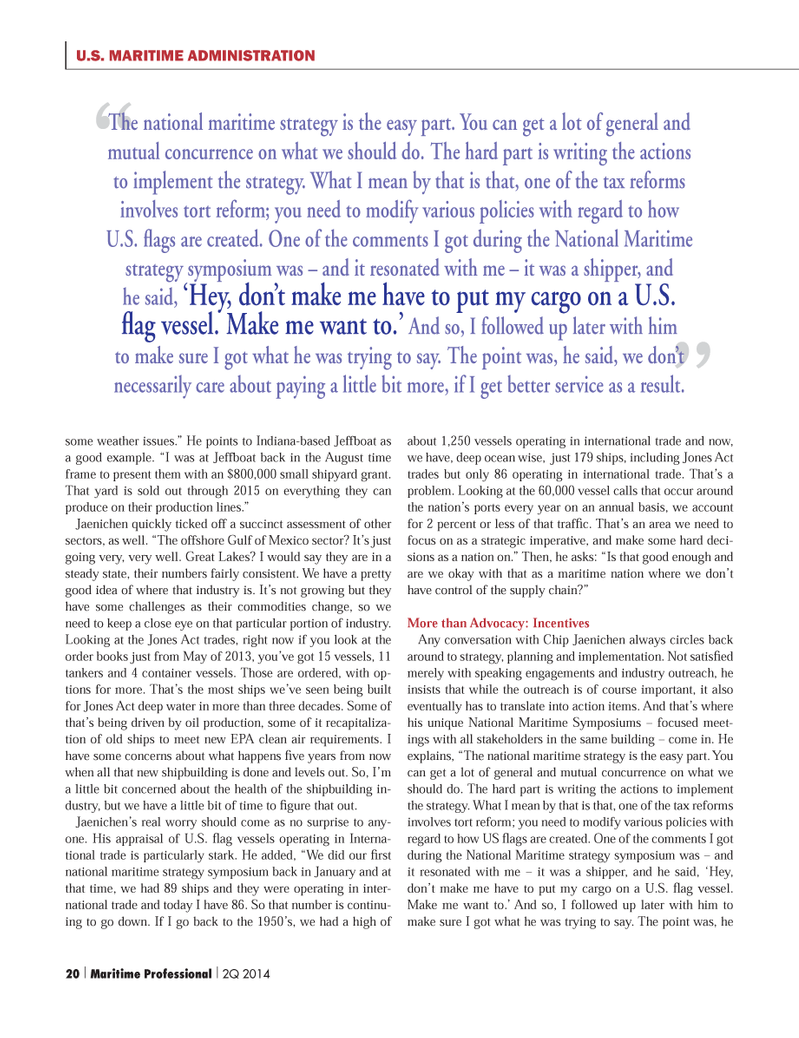
Page 20: of Maritime Logistics Professional Magazine (Q2 2014)
Maritime Risk & Shipping Finance
Read this page in Pdf, Flash or Html5 edition of Q2 2014 Maritime Logistics Professional Magazine
U.S. MARITIME ADMINISTRATION some weather issues.” He points to Indiana-based Jeffboat as a good example. “I was at Jeffboat back in the August time frame to present them with an $800,000 small shipyard grant.
That yard is sold out through 2015 on everything they can produce on their production lines.”
Jaenichen quickly ticked off a succinct assessment of other sectors, as well. “The offshore Gulf of Mexico sector? It’s just going very, very well. Great Lakes? I would say they are in a steady state, their numbers fairly consistent. We have a pretty good idea of where that industry is. It’s not growing but they have some challenges as their commodities change, so we need to keep a close eye on that particular portion of industry.
Looking at the Jones Act trades, right now if you look at the order books just from May of 2013, you’ve got 15 vessels, 11 tankers and 4 container vessels. Those are ordered, with op- tions for more. That’s the most ships we’ve seen being built for Jones Act deep water in more than three decades. Some of that’s being driven by oil production, some of it recapitaliza- tion of old ships to meet new EPA clean air requirements. I have some concerns about what happens fi ve years from now when all that new shipbuilding is done and levels out. So, I’m a little bit concerned about the health of the shipbuilding in- dustry, but we have a little bit of time to fi gure that out.
Jaenichen’s real worry should come as no surprise to any- one. His appraisal of U.S. fl ag vessels operating in Interna- tional trade is particularly stark. He added, “We did our fi rst national maritime strategy symposium back in January and at that time, we had 89 ships and they were operating in inter- national trade and today I have 86. So that number is continu- ing to go down. If I go back to the 1950’s, we had a high of about 1,250 vessels operating in international trade and now, we have, deep ocean wise, just 179 ships, including Jones Act trades but only 86 operating in international trade. That’s a problem. Looking at the 60,000 vessel calls that occur around the nation’s ports every year on an annual basis, we account for 2 percent or less of that traffi c. That’s an area we need to focus on as a strategic imperative, and make some hard deci- sions as a nation on.” Then, he asks: “Is that good enough and are we okay with that as a maritime nation where we don’t have control of the supply chain?”
More than Advocacy: Incentives
Any conversation with Chip Jaenichen always circles back around to strategy, planning and implementation. Not satisfi ed merely with speaking engagements and industry outreach, he insists that while the outreach is of course important, it also eventually has to translate into action items. And that’s where his unique National Maritime Symposiums – focused meet- ings with all stakeholders in the same building – come in. He explains, “The national maritime strategy is the easy part. You can get a lot of general and mutual concurrence on what we should do. The hard part is writing the actions to implement the strategy. What I mean by that is that, one of the tax reforms involves tort reform; you need to modify various policies with regard to how US fl ags are created. One of the comments I got during the National Maritime strategy symposium was – and it resonated with me – it was a shipper, and he said, ‘Hey, don’t make me have to put my cargo on a U.S. fl ag vessel.
Make me want to.’ And so, I followed up later with him to make sure I got what he was trying to say. The point was, he “ ”
The national maritime strategy is the easy part. You can get a lot of general and mutual concurrence on what we should do. The hard part is writing the actions to implement the strategy. What I mean by that is that, one of the tax reforms involves tort reform; you need to modify various policies with regard to how
U.S. fl ags are created. One of the comments I got during the National Maritime strategy symposium was – and it resonated with me – it was a shipper, and he said, ‘Hey, don’t make me have to put my cargo on a U.S. fl ag vessel. Make me want to.’ And so, I followed up later with him to make sure I got what he was trying to say. The point was, he said, we don’t necessarily care about paying a little bit more, if I get better service as a result. 20 | Maritime Professional | 2Q 2014 18-33 Q2 MP2014.indd 20 5/20/2014 9:33:52 AM

 19
19

 21
21
